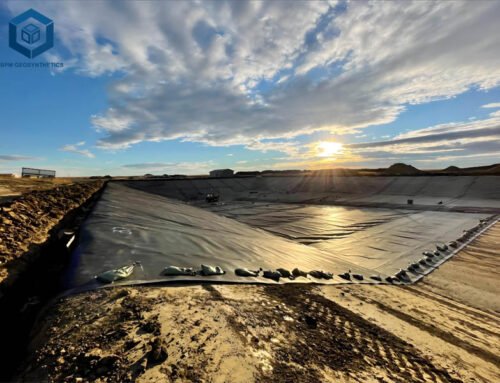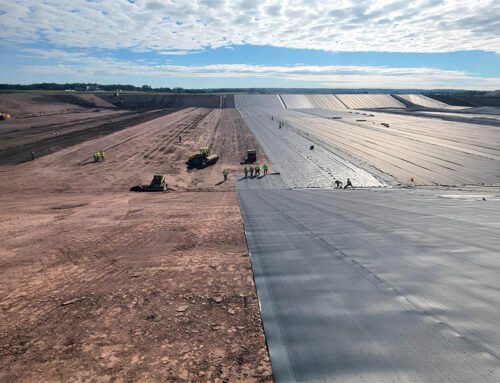Textured geomembrane is used for anti-seepage, waterproofing engineering, etc. Textured HDPE geomembrane has a membrane body, and the surface of the membrane body is rough, which is beneficial for fixation. The membrane body can be rough on one side, and it is best for both the front and back surfaces to be rough. Everyone knows that textured geomembrane has a high coefficient of friction and is commonly used in landfills, but it also has its own disadvantages. This article will briefly elaborate to you.
As the leading Geomembrane manufacturer and supplier, BPM Geomembrane offers a wide range of geomembrane material in custom thickness and size at best factory price.
1. What Is Textured Geomembrane?
Textured geomembranes have a rough surface that enhances the friction coefficient, making them ideal for steep slopes and vertical engineering designs. The textured surface also facilitates seamless thermal fusion welding between adjacent sheets.
These geomembranes are engineered with exceptional shear strength, significant friction angles, excellent elongation properties, and the highest interface surface friction coefficient. They provide enhanced interface strength when in contact with soils, textiles, geosynthetic clay liners, and other critical interfaces.
The degree of texturing in the geomembrane is measured using the ASTM D7466 standard test method, which evaluates the height from the core membrane to the top of the texture peak.
Textured HDPE geomembranes are widely used in slope protection, waste containment, dam lining, and other applications requiring increased friction and interface strength. They maximize the volume and performance of the geomembrane in challenging engineering and environmental conditions.
Specifications of Textured Geomembrane
| Test Properties | Unit | Standard | Test frequency | GSO10 | GSO15 | GSO20 | GSO25 |
| Thickness | mm | D5994 | per roll | 1.00 | 1.50 | 2.00 | 2.50 |
| Asperity Height | mm | D7446 | Every 2nd roll (2) | 0.25 | |||
| Density | g/cc | D1505/D792 | 90,000kg | 0.94 | |||
| Tensile Properties | |||||||
| Yield Strength | KN/m | D6693
Type IV |
9,000 kg | 15 | 22 | 29 | 37 |
| Break Strength | KN/m | 10 | 16 | 21 | 26 | ||
| Yield Elongation | % | 12 | 12 | 12 | 12 | ||
| Break Elongation | % | 100 | 100 | 100 | 100 | ||
| Tear Resistance | N | D1004 | 20,000kg | 125 | 187 | 249 | 311 |
| Puncture Resistance | N | D4883 | 20,000kg | 267 | 400 | 534 | 667 |
| Stress Crack Resistance | hr | D5397
(App) |
per GRI GM-10 | 300 hr | |||
| Carbon black content | % | D4218 | 9,000kg | 2.0-3.0% | |||
| Carbon black dispersion | D5596 | 20,000kg | For 10 different views: 9 in Categories 1 or 2 and 1 in Category 3 | ||||
| Oxidative Induction Time | |||||||
| Standard OIT | min | D3895 | 90,000kg | 100 min | |||
| High pressure OIT | D5885 | 90,000kg | 400 min | ||||
| Oven Aging at 85°C retained after 90 days | % | D5721 | per each formulation | 55% | |||
| Standard OIT | D3895 | 80% | |||||
| High pressure OIT | D5885 | 80% | |||||
| UV Resistance | |||||||
| High Pressure OIT – % retained after 1600 hrs | % | D5885 | per each formulation | 50% | |||
| Roll Width | m | 7 | 7 | 7 | 7 | ||
| Roll Length | m | 210 | 140 | 105 | 70 | ||
| Size stability | % | 2% | |||||


2. What Are The Advantages Of Textured Geomembrane?
Textured geomembranes offer several advantages in various applications. Here are some of the key advantages of using textured geomembrane:
2.1 Enhanced Friction
The textured geomembrane exhibits a high friction coefficient due to the presence of small particles on its surface. These particles enhance the slope’s stability and increase the friction coefficient of the high-strength, high elongation, and environmentally resistant textured geomembrane. As a result, the textured geomembrane maximizes the load-bearing capacity in terms of usable volume compared to a smooth HDPE geomembrane.
2.2 Improved Interface Strength
Textured geomembranes demonstrate high shear strength and interface surface friction coefficient. This attribute ensures a robust bond and improved interface strength when in contact with surrounding soils, geosynthetic materials, or other critical interfaces.
2.3 Reliable Welding
The textured surface facilitates seamless thermal fusion welding between adjacent sheets due to their smooth edges. This enables secure and dependable connections, enhancing the overall integrity and performance of the installation.
2.4 Anti-seepage
The anti-seepage coefficient of textured geomembrane – High strength, high elongation, and environmental resistance. Textured geomembrane has a permeability coefficient K<1.010-13g/cm/cm2. s.pa, which cannot be compared with ordinary waterproof materials.
2.5 Chemical Stability
Textured geomembrane has different chemical stability and is widely used in sewage treatment, chemical reaction tanks, landfill sites, high temperature resistance, asphalt, oil tar resistance, acid resistance, alkali resistance, salt resistance, and more than 80 strong acid and alkali chemical media corrosion.
2.6 Aging Resistance
The textured HDPE geomembrane has good aging resistance, UV resistance, decomposition resistance, and can be used naked. The service life of the material can reach 50-70 years, providing good environmental impermeability.
2.7 Resistant to Plant Roots
3. What Are Disadvantages Of Textured Geomembrane?
While textured geomembranes offer numerous advantages, there are also a few potential disadvantages to consider. Here are some of the drawbacks associated with textured geomembranes:
3.1 Increased Material Costs
The price of textured geomembrane with the same thickness is higher than that of smooth geomembrane.
3.2 Limited Availability
Textured HDPE geomembranes may have a more restricted availability compared to smooth geomembranes. Not all manufacturers or suppliers may offer textured options, limiting the range of choices in the market.
3.3 Installation Challenges
The rough surface texture of textured geomembranes can present installation complexities. The uneven surface requires extra attention and care during placement and welding to ensure proper alignment and secure connections.
3.4 Difficulties in Cleaning
The textured surface of the geomembrane can make cleaning or removing accumulated debris more challenging compared to smooth geomembranes. The rough texture provides additional crevices where particles can become lodged, demanding more maintenance efforts or specialized cleaning techniques.
3.5 Limited Applicability
Textured geomembranes are specifically designed for applications requiring enhanced friction and interface strength. However, in projects where smooth surfaces are preferred or high friction is unnecessary, the use of textured geomembranes may not be the most suitable option.


4. What Is Textured Geomembrane Use For?
Textured geomembranes are utilized in various applications where enhanced friction and interface strength are crucial. Some of the common uses of textured geomembranes include:
4.1 Slope Stabilization
Textured geomembranes are employed to secure and stabilize steep slopes, mitigating soil erosion and reducing the risk of landslides.
4.2 Waste Management
Textured geomembranes are utilized in landfill liners and caps to create a robust barrier that prevents the migration of contaminants into the surrounding environment, ensuring effective waste containment.
4.3 Mining Operations
Textured geomembranes are employed in mining applications such as heap leach pads, tailings impoundments, and acid mine drainage control. They provide reliable containment and environmental protection, safeguarding surrounding areas from contamination.
4.4 Environmental Remediation
Textured geomembranes are utilized in environmental remediation projects, including capping and containing contaminated sites. They create a strong barrier that prevents the spread of pollutants, facilitating effective site cleanup and restoration.
4.5 Hydraulic Engineering
Textured geomembranes are primarily employed in hydraulic engineering to address seepage issues in hydraulic structures like embankments, reservoirs, and channels. Their exceptional seepage resistance capabilities effectively prevent problems such as leakage and piping, ensuring the safety and stability of the project.
5. Summary
BPM textured geomembranes are manufactured to the highest quality standards, ensuring exceptional durability. They are packaged in double woven geotextile and strength belts for added protection. With thickness options ranging from 1.0mm to 3.0mm, BPM textured HDPE geomembranes are suitable for projects requiring increased friction and steeper slopes, such as landfills, mining operations, retaining backfills, and waste containment. Our textured geomembranes have obtained certifications including ISO9001, ISO14001, TUV, Soncap, SASO, BV, and have passed rigorous testing by SGS and Intertek, among others.
If you have any questions, please contact us.





